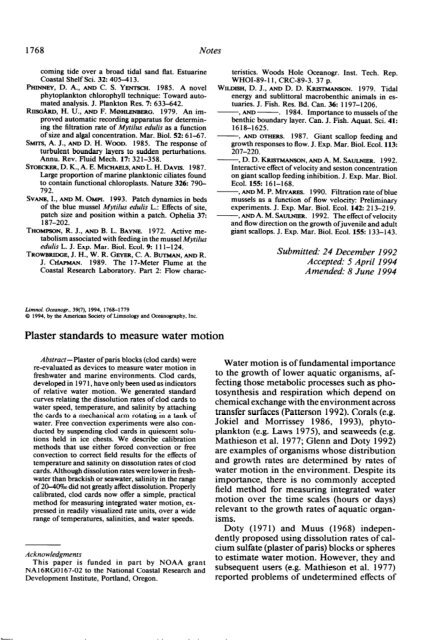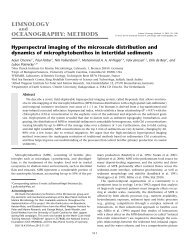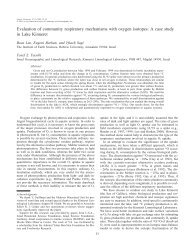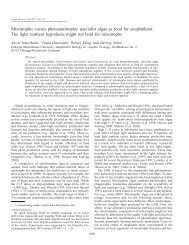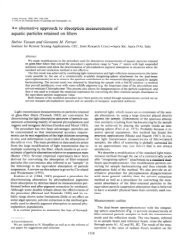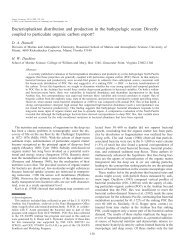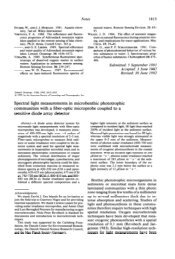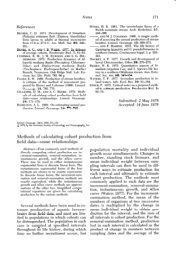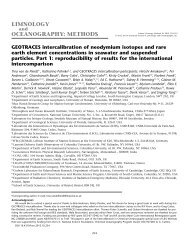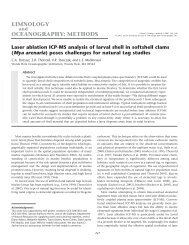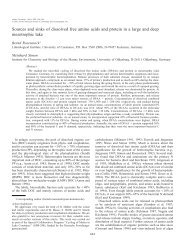Download - ASLO
Download - ASLO
Download - ASLO
You also want an ePaper? Increase the reach of your titles
YUMPU automatically turns print PDFs into web optimized ePapers that Google loves.
1768 Notes<br />
coming tide over a broad tidal sand flat. Estuarine<br />
Coastal Shelf Sci. 32: 4054 13.<br />
PHINNEY, D. A., AND C. S. YENTSCH. 1985. A novel<br />
phytoplankton chlorophyll technique: Toward automated<br />
analysis. J. Plankton Res. 7: 633-642.<br />
RIISGARD, H. U., AND F. MBHLENBERG. 1979. An improved<br />
automatic recording apparatus for determining<br />
the filtration rate of MytiZus edulis as a function<br />
of size and algal concentration. Mar. Biol. 52: 6 l-67.<br />
SMITS, A. J., AND D. H. WOOD. 1985. The response of<br />
turbulent boundary layers to sudden perturbations.<br />
Annu. Rev. Fluid Mech. 17: 321-358.<br />
STOECKER, D. K., A. E. MICHAELS, AND L. H. DAVIS. 1987.<br />
Large proportion of marine planktonic ciliates found<br />
to contain functional chloroplasts. Nature 326: 79&<br />
792.<br />
SVANE, I., AND M. OMPI. 1993. Patch dynamics in beds<br />
of the blue mussel MytiZus edulis L.: Effects of site,<br />
patch size and position within a patch. Ophelia 37:<br />
187-202.<br />
THOMPSON, R. J., AND B. L. BAYNE. 1972. Active metabolism<br />
associated with feeding in the mussel A4ytiZu.s<br />
edulis L. J. Exp. Mar. Biol. Ecol. 9: 111-124.<br />
TROWBRIDGE, J. H., W. R. GEYER, C. A. BuT)~~AN, AND R.<br />
J. -MAN. 1989. The 17-Meter Flume at the<br />
Coastal Research Laboratory. Part 2: Flow charac-<br />
teristics. Woods Hole Oceanogr. Inst. Tech. Rep.<br />
WHOI-89-1 1, CRC-89-3. 37 p.<br />
WILDISH, D. J., AND D. D. KRISTMANSON. 1979. Tidal<br />
energy and sublittoral macrobenthic animals in estuaries.<br />
J. Fish. Res. Bd. Can. 36: 1197-1206.<br />
- 1984. Importance to mussels of the<br />
bend boundary layer. Can. J. Fish. Aquat. Sci. 41:<br />
1618-1625.<br />
- AND OTHERS. 1987. Giant scallop feeding and<br />
growth responses to flow. J. Exp. Mar. Biol. Ecol. 113:<br />
207-220.<br />
-, D. D. KRISTMANSON, AND A. M. SAULNIER. 1992.<br />
Interactive effect of velocity and seston concentration<br />
on giant scallop feeding inhibition. J. Exp. Mar. Biol.<br />
Ecol. 155: 161-168.<br />
-, AND M. P. MIYARES. 1990. Filtration rate of blue<br />
mussels as a function of flow velocity: Preliminary<br />
experiments. J. Exp. Mar. Biol. Ecol. 142: 213-219.<br />
-, AND A. M. SAULNIER. 1992. The effect ofvelocity<br />
and flow direction on the growth ofjuvenile and adult<br />
giant scallops. J. Exp. Mar. Biol. Ecol. 155: 133-143.<br />
Submitted: 24 December 1992<br />
Accepted: 5 April 1994<br />
Amended: 8 June 1994<br />
Limnol. Oceanogr., 39(7), 1994, 1768-1779<br />
Q 1994, by the American society of Limnology and -w-why, Inc.<br />
Plaster standards to measure water motion<br />
Abstract-Plaster of paris blocks (clod cards) were<br />
re-evaluated as devices to measure water motion in<br />
freshwater and marine environments. Clod cards,<br />
developed in 1971, have only been used as indicators<br />
of relative water motion. We generated standard<br />
curves relating the dissolution rates of clod cards to<br />
water speed, temperature, and salinity by attaching<br />
the cards to a mechanical arm rotating in a tank of<br />
water. Free convection experiments were also conducted<br />
by suspending clod cards in quiescent solutions<br />
held in ice chests. We describe calibration<br />
methods that use either forced convection or free<br />
convection to correct field results for the effects of<br />
temperature and salinity on dissolution rates of clod<br />
cards. Although dissolution rates were lower in freshwater<br />
than brackish or seawater, salinity in the range<br />
of 20-4wm did not greatly affect dissolution. Properly<br />
calibrated, clod cards now offer a simple, practical<br />
method for measuring integrated water motion, expressed<br />
in readily visualized rate units, over a wide<br />
range of temperatures, salinities, and water speeds.<br />
Water motion is of fundamental importance<br />
to the growth of lower aquatic organisms, affecting<br />
those metabolic processes such as photosynthesis<br />
and respiration which depend on<br />
chemical exchange with the environment across<br />
transfer surfaces (Patterson 1992). Corals (e.g.<br />
Jokiel and Morrissey 1986, 1993), phytoplankton<br />
(e.g. Laws 1975), and seaweeds (e.g.<br />
Mathieson et al. 1977; Glenn and Doty 1992)<br />
are examples of organisms whose distribution<br />
and growth rates are determined by rates of<br />
water motion in the environment. Despite its<br />
importance, there is no commonly accepted<br />
field method for measuring integrated water<br />
motion over the time scales (hours or days)<br />
relevant to the growth rates of aquatic organisms.<br />
Doty (197 1) and Muus (1968) independently<br />
proposed using dissolution rates of calcium<br />
sulfate (plaster of paris) blocks or spheres<br />
to estimate water motion. However, they and<br />
subsequent users (e.g. Mathieson et al. 1977)<br />
reported problems of undetermined effects of
Notes 1769<br />
salinity and temperature on results. Nevertheless,<br />
the clod cards proposed by Doty are easily<br />
prepared with standard ice-cube trays as molds<br />
and are suited to marine studies because they<br />
are large enough to be left out through a tide<br />
cycle without dissolving completely. It is a<br />
convenient and inexpensive method of measuring<br />
water motion in field studies. We have<br />
attempted to define the behavior of clod cards<br />
with respect to temperature and salinity and<br />
to develop calibration methods to enhance their<br />
usefulness.<br />
In his original description, Doty (197 1) recommended<br />
expressing field results as a “diffusion<br />
increase factor” (DF), defined as the<br />
ratio of weight loss of clod cards placed in the<br />
field to the weight loss of clod cards from the<br />
same batch held under specified still-water<br />
conditions in the laboratory. DF was meant to<br />
express the multiplication factor of diffusion<br />
in the field relative to diffusion in the absence<br />
of water motion. Unfortunately, his reported<br />
still-water values sometimes varied inexplicably<br />
among batches of clod cards that had<br />
been prepared and measured the same way.<br />
This variation introduced a large potential error<br />
into the calculation of DF, since this relatively<br />
small number is used as a divisor.<br />
Doty’s laboratory calibration method consisted<br />
of placing five clod cards on the bottom<br />
of a 15-cm-diameter container to which 2 liters<br />
of test solution were added. The water (motionless)<br />
was changed every day for 4 d. The<br />
initial and final dry weights of the clod cards<br />
were used in the DF calculations. Howerton<br />
and Boyd (1992) as well as Jokiel and Morrissey<br />
(1993) have demonstrated that the calibration<br />
container must have a minimum volume<br />
of 20 liters per clod card if it is to accurately<br />
represent weight loss due to diffusion in totally<br />
calm water.<br />
An additional problem is created by stratification<br />
in the calibration container, particu-<br />
larly when the clod cards are placed on the<br />
bottom. When a solid dissolves in quiescent<br />
water, material from the solid dissolves and<br />
diffuses away from the surface, producing a<br />
solution near the solid that is denser than the<br />
water itself. This solution flows downward, and<br />
the resulting flow increases the dissolution rate.<br />
However, the dense solution may “pool” on<br />
the bottom of the container, creating a layer<br />
of solution with a higher concentration of the<br />
dissolving material than in the bulk liquid. If<br />
the dissolving solid is placed on the bottom of<br />
the container, it will generate a layer of relatively<br />
concentrated liquid that will retard the<br />
dissolution rate compared to the solid in pure<br />
bulk solution.<br />
In unpublished experiments pointing the way<br />
to an improvement in methodology, Doty attached<br />
clod cards to a rotating arm in a tank<br />
of seawater and found that the dissolution rates<br />
of the cards were proportional to the rate at<br />
which they moved through the water. He called<br />
the apparatus a “water motion simulator”<br />
(WAMOSI) because it was the clod card, not<br />
the water, that was moving. The raw data tabulation<br />
of that study (Doty et al. 1986) shows<br />
that despite differences in apparent still-water<br />
dissolution rates among different batches of<br />
clod cards, their actual dissolution rates on the<br />
rotating arm were reproducible at a given velocity.<br />
Subsequently, Glenn and Doty (1992)<br />
used the rotating-arm calibration method in<br />
combination with field measurements to show<br />
that 85-98% of the variability of growth rates<br />
of eucheumatoid red seaweeds across seasons<br />
on a reef flat in Hawaii could be explained by<br />
water motion. These experiments indicated<br />
that calibrated clod cards would be valuable<br />
tools for correlating growth rates with water<br />
motion in the marine environment.<br />
Recently, Howerton and Boyd (1992) used<br />
clod cards to measure circulation patterns in<br />
aquaculture ponds, and Jokiel and Morrissey<br />
(1993) used clod cards to study water motion<br />
on coral reefs. In both studies, the investigators<br />
improved the still-water calibration method<br />
by increasing the volume of water into which<br />
the cards dissolve, and they measured rates of<br />
still-water dissolution of the cards as functions<br />
of duration of exposure, temperature, and salinity.<br />
Both studies used a rotating arm to estimate<br />
dissolution rates as a function of water<br />
velocity at a single temperature and salinity.<br />
They concluded that clod cards were valuable<br />
in measuring relative rates of water motion<br />
but, similar to earlier investigators, cited the<br />
need for equations relating card dissolution<br />
rates to fluid velocity as influenced by temperature<br />
and salinity before they could be used<br />
to measure absolute water velocities. Deriving<br />
and validating these equations was the purpose<br />
of our study.<br />
Clod cards were prepared essentially ac-
1770 Notes<br />
r=0.15<br />
(typ.)<br />
‘F q-<br />
El<br />
_<br />
I<br />
/‘ ‘\,<br />
+45cm+<br />
/F$2+.,<br />
\<br />
3.3cm<br />
T=T<br />
Bottom surface sanded<br />
to adjust weight<br />
to 30 f 1.5 g<br />
Fig. 1. Dimensions of the clod cards.<br />
cording to the methods of Doty (197 1) and<br />
Howerton and Boyd (1992), except that neither<br />
the starting plaster of paris nor the finished<br />
cards were oven-dried before use. Our clod<br />
cards were made from reagent-grade plaster of<br />
paris (calcium sulfate hemihydrate, EM Science<br />
Co.) with 335 ml of water per 500 g. We<br />
slowly added plaster of paris to the water<br />
as we stirred it with a spoon; we poured the<br />
slurry into flexible plastic ice-cube trays and<br />
allowed it to harden for 20-30 min before removing<br />
the clod cards. We tapped the trays<br />
vigorously several times while the mixture was<br />
still liquid to dislodge air bubbles. Sometimes,<br />
a thin layer of liquid covered the surface of the<br />
hardening clod cards in the trays. This layer<br />
was decanted before the cards were removed.<br />
After removal, the cards were dried for 3 d or<br />
longer on a laboratory bench, and the bottoms<br />
were sanded until the cards had uniform weight<br />
within a batch (within 1.5 g); they were then<br />
glued to 5- x 7-cm sheets of waterproof plastic<br />
(Nalgene PolyPaper) with silicone cement.<br />
Weight loss due to water exposure was quantified<br />
by weighing dry clod cards before exposure,<br />
placing them in the test solution for<br />
24 h, allowing them to redry for 3 d or longer<br />
on a laboratory bench, and then reweighing<br />
them.<br />
The ice-cube trays used in these experiments<br />
produced clod cards of shape and dimensions<br />
shown in Fig. 1. Internally, the dry cards had<br />
a foam structure with numerous interconnected<br />
minute air spaces within the calcium sulfate<br />
matrix. The cards had densities of 1.19-l .21<br />
/<br />
at 25°C and weighed 28-32 g each. When placed<br />
in test solutions, the cards were fully saturated<br />
within 5 min, absorbing from 10 to 12 ml of<br />
solution.<br />
Water motion experiments were carried out<br />
inside a greenhouse in a shallow, wooden-sided,<br />
square tank (2.1 m long, 0.36 m deep) with<br />
a plastic liner (Fig. 2). The tank was filled with<br />
test solution to a depth of 25 cm (solution<br />
volume, 1.1 m3) and covered with sheets of<br />
Styrofoam to control temperature during each<br />
24-h run. Test solutions were chilled by circulating<br />
the water through a 124-W refrigeration<br />
unit with external thermostat by means<br />
of a 30-W circulation pump. Solutions were<br />
heated with a thermostat-controlled, 150-W<br />
immersion heater.<br />
Clod cards were attached at various positions<br />
along a 2-m stainless steel arm (1 cm<br />
thick) which was rotated in the tank at 2.4 rpm<br />
by a 37-W electric gear motor secured over the<br />
middle of the tank by an external wooden<br />
framework. The cards were mounted on the<br />
arm by attaching them with rubber bands to<br />
rigid PVC-plastic plates (5 x 7.5 cm, 0.3 cm<br />
thick) screwed to the arm. Five cards were<br />
mounted along each of the two radii at distances<br />
from the center of 7, 27,47,67, and 87<br />
cm. Thus, each position was represented by<br />
duplicate cards moving through the water at<br />
nominal velocities ranging from 1.8 to 2 1.8<br />
cm s-l, which are within the range of water<br />
velocities encountered on tropical reef flats<br />
(Glenn and Doty 1992) but lower than extreme<br />
tidal bores, which are up to 80 cm s-l (Mathieson<br />
et al. 1977). Greater velocities can be<br />
achieved by selecting a gear motor with a higher<br />
rotation rate (Howerton and Boyd 1992) or<br />
by using a longer rotating arm (Jokiel and Morrissey<br />
1993).<br />
Dissolution rates under free convection conditions<br />
were determined by suspending clod<br />
cards by wires 5 cm below the surface of 60<br />
liters of solution contained in ice chests. The<br />
ice chests were kept under constant temperature<br />
in an undisturbed indoor location during<br />
each 4-6-d run. The cards were withdrawn and<br />
weighed wet each day, then replaced in the<br />
chests.<br />
Three solutions were tested in the water motion<br />
tank: tapwater, brackish water, and seawater.<br />
Tapwater was from the Tucson municipal<br />
supply, and seawater was collected from
Notes 1771<br />
T<br />
2.1 m<br />
mounted<br />
arm<br />
mounte~~~~a level<br />
k- 2.1 m 4<br />
Fig. 2. Design of the water motion simulator.<br />
a seaside well in the upper Gulf of California<br />
at Puerto Pefiasco, Sonora, Mexico. Brackish<br />
water was a 1 : 1 mixture of tapwater and seawater.<br />
Salinities by refractometer were 0, 20,<br />
and 407~. Solutions were measured for temperature,<br />
pH, and electrical conductivity at the<br />
start and finish of each run. Samples of each<br />
solution were analyzed for cations and anions,<br />
including calcium and sulfate, by AOAC<br />
methods (Laboratory Consultants, Tempe, Ar-<br />
Table 1. Analyses of tapwater, brackish water, and seawater<br />
used in clod card calibration experiments.<br />
Constituent<br />
Tapwater 20%3 40%<br />
Calcium 1.46 7.06 13.20<br />
Sulfate 0.85 16.66 33.94<br />
Boron 0.008 * 0.473<br />
Magnesium 0.417 * 61.6<br />
Sodium 2.13 * 534.8<br />
Chloride 1.71 * 630.4<br />
Fluoride 0.056 * 0.078<br />
PH 8.1-8.5 8.1-8.2 8.2-8.3<br />
EC (mmhos cm-‘) 715 34,000 71,500<br />
* Brackish water (20%~) was a I : 1 mixture of tapwater and 40% water. Analyses<br />
of elements of limited importance to this study were omitted for this<br />
mixture.<br />
(mol<br />
m-l)<br />
izona, and the Soil and Water Testing Laboratory,<br />
University of Arizona, Tucson) (Table<br />
1). Solutions in the tank were changed after 2-<br />
3 runs of clod cards to reduce accumulation<br />
of calcium sulfate in the water. The ice-chest<br />
experiments used an additional solution, 25o/oo<br />
salinity, also prepared by dilution of tapwater<br />
and seawater.<br />
Weight loss of clod cards vs. water motion<br />
is expected to be a decreasing rather than a<br />
linear function, because the exposed area of<br />
the clod diminishes as dissolution proceeds.<br />
The rate of dissolution of a solid in an aqueous<br />
solution can be expressed as<br />
dW<br />
- = -kAAC.<br />
d6<br />
W is the weight of the solid, 8 is time, k the<br />
mass transfer coefficient, A the exposed area<br />
of the solid, and AC the concentration difference<br />
between the dissolved solid in the liquid<br />
at the solid-fluid interface and in the bulk liquid.<br />
The dissolution of solids, including the diffusion<br />
process across boundary layers, is described<br />
in detail in several mass transfer texts
1772<br />
Notes<br />
J<br />
1.0<br />
2<br />
E 0.9<br />
L<br />
2 0.6<br />
P<br />
< 0.7<br />
t 0.6<br />
0.010<br />
1 10 100<br />
Velocity, cm s-1<br />
Fig. 3. Plot ofclod card weight loss vs. velocity through<br />
32o/oo seawater for data from Glenn and Doty (1992) used<br />
in the form of Eq. 3 (their data extend to higher velocities<br />
than our work). The slope of the regression line is<br />
0.838kO.042.<br />
0.5<br />
0.4 r I<br />
0 5 10 15 20 25 30<br />
Temperature, "C<br />
Fig. 4. Correction factor for clod card data with T,, =<br />
298°K and pref = viscosity of pure water at 25°C. The four<br />
lines correspond to salinities of 0, 10, 20, and 40%~ from<br />
top to bottom. Calculated with viscosity data from Riley<br />
and Skit-row (1975).<br />
(e.g., Cussler 1984; Sherwood et al. 1975; Skelland<br />
1974). For solids of sample geometries<br />
which dissolve uniformly, the area and weight<br />
relationship can be approximated as<br />
A (2)<br />
Ai and Wi represent the initial area (exposed)<br />
and weight of the solid. For clod cards, this<br />
approximation is useful until > 50% of the clod<br />
has dissolved or longer, depending on the velocity<br />
of the fluid.<br />
The mass transfer coefficient is also influenced<br />
by the change in clod dimensions; however,<br />
the effect is usually minor until well into<br />
the dissolution process. Equations 1 and 2 can<br />
be combined and integrated to give<br />
1 - (?r = ;k($A,. (3)<br />
Wr is the final weight of the clod after time 8<br />
has elapsed. Equations 3 is useful for data analysis;<br />
the mass transfer coefficient usually varies<br />
with the fluid velocity raised to a power (P),<br />
so a log-log plot of [l - (WJ/ Wi)“] against<br />
velocity should yield a straight line. This is<br />
illustrated in Fig. 3 with the data of Glenn and<br />
Doty (1992). Equation 3 can be rearranged to<br />
give an expression for the overall fraction of<br />
weight 10~s (A W/ Wi):<br />
Assuming that AC remained constant during<br />
dissolution, experimental data at a given temperature<br />
and salinity were correlated with the<br />
model<br />
( )<br />
l/3<br />
Wf = aVm.<br />
I- j7<br />
I<br />
The constants a and m can be determined experimentally<br />
by means of the rotating arm, and<br />
weight loss data from clod cards exposed in<br />
the field can then be used in Eq. 5 to determine<br />
water motion.<br />
The effect of temperature at a given salinity<br />
and CaSO, concentration was corrected by using<br />
the group (T/T,,) (p,.,&) to normalize data<br />
to a reference temperature, where Tis absolute<br />
temperature, and p is viscosity. This group (Fig.<br />
4) is typically used to estimate the changes in<br />
diffusion coefficients (Reid and Sherwood<br />
1966) with varying solution strength.<br />
From Eq. 1 and 3, the dissolution rates are<br />
also dependent on the concentration of CaSO,<br />
in the bulk water and factors influencing the<br />
concentration, such as the ionic strength of the<br />
bulk water. To determine the concentration<br />
difference, we assume the solution at the gypsum-water<br />
interface is saturated with CaSO,<br />
and determine AC with the solubility product<br />
as<br />
Ksp = [Ca2+]i[S042-]i<br />
g= 1 - 11 - ;k($)ACO13. (4)<br />
or<br />
= ([Ca’+], + AC)([S042-]b + AC) (6)
Notes<br />
1773<br />
0.022<br />
30<br />
0.020<br />
i b 0.019<br />
c -<br />
5 0.016<br />
E<br />
- 0.017<br />
2<br />
0.016<br />
I<br />
0.015<br />
25<br />
I<br />
2 20<br />
0<br />
c g 15<br />
8<br />
2<br />
10<br />
5<br />
Corrected Velocity _<br />
0.014<br />
u 5 10 15 20 25 30 35 40<br />
Salinity, 20<br />
0 A<br />
0<br />
30 40 50 60<br />
Rodius. cm<br />
Fig. 5. Calculated concentration difference of CaSO,<br />
between the solid-liquid interface and bulk solution of<br />
clod cards in natural seawater sources based on Eq. 7.<br />
Curve A was calculated based on literature values of seawater<br />
chemical content at 32%1 and assuming that seawater<br />
was diluted with distilled water to achieve the lower salinities;<br />
curve B was calculated based on chemical analyses<br />
of Puerto Peiiasco seawater at 40?&0 and Tucson tapwater<br />
used as the diluent in our study.<br />
Ac =<br />
1(<br />
_<br />
[Ca2+lb + W42% 2 + K Oo5<br />
2 1<br />
SP<br />
I<br />
Ka2+lb + W42- lb<br />
2 ) . (7)<br />
[Ca2+]i, [Ca2+lb, [S042-]i, and [S042-]b are calcium<br />
and sulfate ion concentrations at the interface<br />
and in the bulk solution. Ksp is the solubility<br />
product, which can be computed by the<br />
expressions given by Marshall and Slusher<br />
(1968), who allow for the presence of ion pairs<br />
such as MgS040 in their correlations.<br />
The values of [Ca2+16 and [S042-]b used in<br />
Eq. 7 are based on the total calcium and sulfate<br />
measured in solution; we have made no attempt<br />
to correct these concentrations for the<br />
presence of ion pairs containing calcium or<br />
sulfate. Increasing the ionic strength (or salinity)<br />
increases the CaSO, solubility product,<br />
thereby increasing the gradient between the interface<br />
and the bulk solution and accelerating<br />
the dissolution rate of a clod card. However,<br />
this effect is counteracted if the concentration<br />
of CaSO, in the bulk solution increases with<br />
salinity, which is the case with seawater; the<br />
seawater used in our experiments contained<br />
CaSO, at concentrations more than eight times<br />
that of the freshwater supply. The brackish<br />
supply, prepared by dilution, was intermediate.<br />
Figure 5 contains salinity correction curves<br />
Fig. 6. Correction for the induced-water-motion effect<br />
of the rotating arm in the tank. Top line is the velocity of<br />
the clod card in the tank at each position on the arm;<br />
bottom line is the velocity of the water in the tank estimated<br />
by the movement of suspended particles in the<br />
water; middle line is the corrected velocity used to correlate<br />
the card dissolution rates with water motion.<br />
based on Puerto Peiiasco seawater and Tucson<br />
tapwater used in our study (curve B) and on<br />
literature values of normal seawater constituents<br />
(Hansson 1973) assumed to be diluted<br />
with distilled water (curve A). Curve B falls<br />
below curve A because Tucson tapwater and<br />
Puerto Pefiasco seawater contain proportionally<br />
more CaSO, than distilled water and standard<br />
seawater.<br />
The water motion tank was used to obtain<br />
data for velocity-weight loss correlations. The<br />
velocity of the clod card through the water was<br />
easily calculated from the rotation rate of the<br />
arm and the distance of the card from the center<br />
of rotation. However, it was necessary to<br />
correct for the rotary movement imparted to<br />
the water in the tank by the moving arm. This<br />
movement was determined at each of the five<br />
positions by measuring the movement of small<br />
suspended particles in the water. A drag model<br />
was correlated to the data and used to correct<br />
the velocities of the cards into estimates of<br />
their velocities relative to the water at each<br />
position (Fig. 6). The correction was more significant<br />
at low than at high velocities.<br />
Forced convection tests were run at temperatures<br />
from 13 to 35°C in three different<br />
salinities on the rotating arm (Fig. 7). Plots in<br />
the form of Eq. 5 were subjected to regression<br />
analyses (Table 2). In all runs, clod card weight<br />
loss at the lowest test velocity was increased<br />
by free convection, and the points fell - 15%<br />
above the curve of best fit to the other points;
1774 Notes<br />
0.6<br />
A 25.5’<br />
A 30.5.<br />
0 33.5.<br />
Table 2. Regression analyses of clod card runs at various<br />
salinities and temperatures. The model equation was<br />
in the form [ 1 - (WI W,)]” = a I/‘“; both sides of the equation<br />
were converted to natural logarithms to reduce the<br />
equation to a linear function for analysis.<br />
a<br />
0 2 4 6 6<br />
Velocity. cm a-l<br />
14 16<br />
20<br />
0 13.0 8 0.0146 0.653 0.992 3.16<br />
0 19.5 8 0.0126 0.749 0.992 3.67<br />
0 25.5 8 0.0157 0.772 0.997 2.49<br />
0 30.5 8 0.0178 0.750 0.984 5.33<br />
0 33.5 8 0.0187 0.799 0.996 2.81<br />
20 12.0 8 0.0141 0.765 0.988 4.73<br />
20 19.0 8 0.0136 0.823 0.991 4.43<br />
20 25.5 8 0.0164 0.867 0.990 4.75<br />
20 30.7 8 0.0180 0.868 0.997 2.95<br />
40 13.0 8 0.0130 0.768 0.994 3.24<br />
40 24.5 8 0.0183 0.793 0.998 2.53<br />
40 28.3 8 0.0307 0.757 0.987 4.84<br />
Temperature compensated<br />
0 40 0.0162<br />
20 32 0.0176<br />
40 24 0.0204<br />
0.745 0.965 6.94<br />
0.83 1 0.976 6.41<br />
0.773 0.984 4.93<br />
0.6<br />
V.”<br />
0 2 4 6 6 10 12 14 16 16 20<br />
Velocity, cm *-l<br />
0 13% (4O.h.) C<br />
0 2 4 6 6 10 12 14 16 16 20<br />
Velocity, cm se1<br />
Fig. 7. Temperature curves for clod cards run at different<br />
velocities in tapwater (A), brackish water (B), and<br />
seawater (C). Lines were fit to data points using Eq. 5.<br />
hence, data for the lowest velocity were omitted<br />
from curve fitting. The model equation can<br />
be used to calculate V as long as the velocity<br />
is >2 cm s-l.<br />
Coefficients of determination (r2) were 0.98<br />
or higher, and percent error of estimates of y<br />
were in the range 2.5-6.0%. Although m varied<br />
somewhat, the mean value was -0.8, the value<br />
expected for mass transfer from a flat surface<br />
in a turbulent flow (Skelland 1974). As expected,<br />
increased temperatures accelerated the<br />
dissolution rates of clod cards at all test salin-<br />
ities. For the temperature-compensated sequence<br />
of Table 2, [ 1 - ( Wr/ Wi)“] was divided<br />
by (T/T,,,) (P,&). Note that temperature-corrected<br />
data fell onto a response surface of the<br />
shape predicted by calculations of AC (Fig. 8).<br />
The effects of both temperature and salinity<br />
variations are included in the experimental data<br />
correlation (Eq. 8). Dissolution rates were lower<br />
in tapwater than in brackish water or seawater<br />
at a given temperature, but over the range<br />
20-40?& salinity had a minor effect on dissolution<br />
rates. Hence, salinity does not appear<br />
to be a major factor controlling dissolution<br />
rates in marine systems.<br />
The dimensional equation fitting our data is<br />
%=I -[I -0.71(~)($-Jy)<br />
(8)<br />
with Y = 0.985. The concemration difference,<br />
AC,, (mol liter-‘), is computed at 25°C by<br />
means of Eq. 7 or Fig. 4; 8 is expressed in days<br />
and V in cm s-l. The average ratio of Ai : Wi<br />
for our clod cards was 1.38 cm2 g- l.<br />
The results of mass transfer experiments are<br />
commonly reported in terms of the appropriate<br />
dimensionless groups, although most readers<br />
will likely find equations such as Eq. 8 more
Notes 1775<br />
Note: Data adjusted to 25%<br />
Fig. 8. Temperature-corrected data for clod cards run at different velocities in tapwater (O?%O), brackish water (20%0),<br />
and seawater (40%0). The data points are superimposed on a response surface based on Eq. 4 with k proportional to<br />
W.s and with AC calculated from Eq. 7 for Puerto Peiiasco seawater. Note that experimental data points fall on the<br />
response surface except at lowest velocity where free convection affects dissolution rates of the cards.<br />
convenient for use with marine systems since<br />
all the information required can usually be obtained<br />
from Figs. 4 and 5. Our forced convection<br />
data can also be described by the expression<br />
NSh = 0 . 059NgtN SC N - (9)<br />
Ns,, is the Sherwood number (kLID,), NRe the<br />
Reynolds number (L VP/~), and Nsc the Schmidt<br />
number (p/pDJ In the dimensionless groups,<br />
k is the mass transfer coefficient evaluated with<br />
Eq. 3 (with AC evaluated at solution temperature<br />
and salinity), D, the volumetric molecular<br />
difhtsion coefficient, p the viscosity, p the<br />
liquid density, and L a geometry term determined<br />
by the shape and orientation of the object.<br />
The geometry term introduced by Pasternak<br />
and Gauvin (1960) was used, where L<br />
= (surface area of body) + (perimeter of projected<br />
area perpendicular to flow). The mounting<br />
card was included in the calculation of the<br />
geometry term. The average value of L in these<br />
studies was 5.4 cm.<br />
Fluid properties were evaluated based on the<br />
bulk solution, with density and viscosity data<br />
from Riley and Skirrow ( 197 5). Diffusion co-<br />
efficients were calculated from equations given<br />
by Cussler (1984), Perry and Chilton (1973),<br />
and Dickson and Whitfield (198 1). Despite the<br />
large amount of information in the literature<br />
on scale formation in seawater, no experimental<br />
values for CaSO, diffusion coefficients in<br />
seawater could be located to compare with the<br />
computed values. At 25”C, the spread in the<br />
values of the difhtsion coefficients for the different<br />
salinities was on the order of 5%.<br />
Figure 9 compares our clod card data and<br />
those of Glenn and Doty (1992) with equations<br />
for spheres and flat plates. Glenn and Doty did<br />
not include a number of details relating to their<br />
clod cards and calibration conditions (e.g. block<br />
dimensions, water temperature, and salinity),<br />
so we did not use their data in obtaining Eq.<br />
9. With respect to other geometries, the clod<br />
card data are roughly the same magnitude as<br />
predicted by the sphere equation (Pasternak<br />
and Gauvin 1960), but the slope is different,<br />
possibly due to the presence of the mounting<br />
card. The flat-plate equation (Skelland 1974)<br />
parallels the clod card data but is substantially<br />
lower.<br />
Both Doty (197 1) and Muus (1968) expe-
1776<br />
Notes<br />
1000<br />
500<br />
< 200<br />
p 100<br />
7<br />
f 50<br />
3 Tap. ’<br />
v 20 30<br />
0 32 30<br />
b 40 “/.o<br />
0.5<br />
e- 0.4<br />
B<br />
z- 0.3<br />
P<br />
E<br />
6<br />
z<br />
0.2<br />
0 Baker (Tap, 30.3YZ)<br />
A EMS (Tap, 30.5’C)<br />
20<br />
f 0.1<br />
10<br />
200 500 1000 2000 5000 lE4 2E4 5E4 lE5<br />
Fig. 9. Comparison of clod card data with the equation<br />
of Pastemak and Gauvin (1960) for spheres (dashed line)<br />
and the equation for a flat plate (Skelland 1974), represented<br />
by the dotted line. The data of Glenn and Doty<br />
(1992) for 32960 seawater are shown, but were not used in<br />
obtaining Eq. 12. The points below iVRe = 1,000 are increased<br />
by natural convection and were also omitted from<br />
the correlation.<br />
NRI?<br />
rienced problems of variability of weight loss<br />
under uniform conditions by clod cards from<br />
the same batch. Referring to Fig. 2, the variability<br />
of clod card weight loss in our tests can<br />
be estimated by comparing the loss from<br />
matched pairs of cards at the same radial position<br />
on the arm (1, 2, 3, . . .) but on opposite<br />
sides of the arm. For all of our runs with<br />
EM Science plaster of paris at the different temperatures,<br />
salinities, and speeds, the standard<br />
deviation of the weight loss differences, as<br />
[CA w/KLIe* - (A IV/ WJsideZ], was 0.0135,<br />
while the overall average difference was 7.7 x<br />
10m4 (n = 60), which is not significantly different<br />
from zero (P = 0.05). Extreme variability<br />
of weight loss within a batch of cards<br />
caused no problems during our tests.<br />
We also ran limited tests with plaster of paris<br />
from Sargent-Welsh Chemical Co. (technical<br />
grade) and from Baker Scientific Co. (reagent,<br />
extra-fine powder ~44 pm, suitable for electrophoresis<br />
gel). The Sargent-Welsh material<br />
produced clod cards of the same density as the<br />
EM Science material used throughout these<br />
tests; a slight excess of water (375 ml : 500 g)<br />
used with the Sargent-Welsh plaster also failed<br />
to alter the final density. There was no significant<br />
difference between the dissolution rates<br />
of cards made with the Sargent-Welsh plaster<br />
and those made with EM Science material when<br />
tested under the same conditions. The cards<br />
made with plaster from Baker Scientific are of<br />
more interest because of their higher density:<br />
6 6 10 12<br />
Velocity, cm s -’<br />
2 5 1U LO<br />
Velocity, cm s -’<br />
Fig. 10. Effect of clod card density on dissolution rates.<br />
Cards made from reagent-grade plaster of paris from Baker<br />
had densities 50% higher than cards made with material<br />
from EMS. Upper plot illustrates differences in dissolution<br />
rates between the two batches, while the slopes of the lines<br />
in the lower plot of the same data, adjusted by the term<br />
Wi/Ai, are not significantly different (P > 0.05). Points<br />
below V = 2 cm s-l, influenced by free convection, were<br />
omitted from the analysis.<br />
1.8 g cm-3 as opposed to 1.2 for our standard<br />
EM Science material. High density cards are<br />
likely to be preferable for fieldwork because<br />
they take longer to dissolve than lower density<br />
cards of the same volume, and they tend to be<br />
stronger and less likely to be accidentally broken<br />
or chipped during handling. Figure 10 indicates<br />
that Eq. 8 holds for both high- and lowdensity<br />
cards when the proper values Of Ai/ Wi<br />
(1.38 for EMS and 0.92 cm* g-l for Baker) are<br />
used. Despite these results, one should use caution<br />
in changing the source or grade of plaster<br />
of paris; materials are occasionally added to<br />
building-grade material to lower the solubility<br />
and enhance water resistance.<br />
In addition to the rotating arm method for<br />
calibrating clod cards, we also wanted to pursue<br />
Doty’s (1971) and Howerton and Boyd’s<br />
(1992) suggestions for a free-convention meth-
od of calibrating that could be used in the field<br />
in the absence of the rotating arm apparatus.<br />
In quiescent solutions or solutions with very<br />
low forced convection rates, the density difference<br />
between the (saturated) liquid-solid interface<br />
and the bulk solution drives a convection<br />
current which is the principal mechanism<br />
that moves solution away from the solid. The<br />
natural and forced convection terms are in<br />
general not directly additive (Pei 1965; Churchill<br />
1977) in determining total convection or<br />
the dissolution rates.<br />
We suspended clod cards in quiescent solutions<br />
in ice chests under constant temperature<br />
conditions indoors. The ice chests supported<br />
dissolution rates roughly following Eq.<br />
4 over 4-6 d (Fig. 11A); Fig. 11 B correlates<br />
the natural convection ice-chest data. The<br />
equation fitting the data is<br />
[ 1 - ( W,lWi)1’3]/8<br />
= 2.81 ($)[(&)(+L.,,] 1.25 (10)<br />
with r = 0.994.<br />
Equations 8 and 10 can be combined to<br />
give an expression that will allow an equivalent<br />
integrated velocity to be determined from<br />
data obtained in the field. The group Sn =<br />
[ 1 - (~~ Wi)“]lB is obtained in natural convection<br />
clod card tests with water from the<br />
field test site. Weight loss data from cards exposed<br />
to water motion in the field is reduced<br />
to a corresponding form:<br />
Then the integrated<br />
calculated as<br />
Sf = [ 1 - ( Wr/ Wi)“]/8-<br />
water speed in the field is<br />
I/= 4.31(5=(y). (11)<br />
S’.25/Sn is similar to DF (Doty 197 1) but should<br />
be superior as an indicator of water motion in<br />
that it corrects for the effects of decreasing surface<br />
area during the tests and the greater effect<br />
of forced convection in producing dissolution<br />
relative to free convection (the 1.25 exponent<br />
for S&<br />
If field tests are conducted in water with lim-<br />
12<br />
'; 0.03<br />
0<br />
3<br />
?<br />
-y 0.02<br />
c<br />
r'<br />
Y<br />
C<br />
a ~0~/6.,25~C,n=Z<br />
. 25 3.. 16.5-C<br />
Time, d<br />
0.04<br />
, 0 Tap<br />
0 20 '/..<br />
0.01<br />
0.01<br />
0.02<br />
(T/T~~)&/P) AC250 mol Ihr-'<br />
A .<br />
Fig. 11. Free convection data obtained by suspending<br />
clod cards in large volumes of quiescent solutions in ice<br />
chests (A), and (B) correlation of the data using Eq. 8 at<br />
T,, = 298°K (25°C).<br />
ited motion, say V < 2 cm s-l, Eq. 11 will<br />
give erroneous results because free convection<br />
forces can also produce dissolution in the field.<br />
If it is necessary to separate the forced and free<br />
convection effects, multiply the right-hand side<br />
of Eq. 11 by [ 1 - (SJSf)3]5/12. This is a rough<br />
correction derived from Churchill (1977) for<br />
heat transfer with assisting forced and free convection.<br />
Many of the applications for clod cards involve<br />
measurement of unsteady flow, ranging<br />
from wind waves to oscillatory tidal currents.<br />
The methods presented here will indicate an<br />
integrated average speed near the scalar arithmetic<br />
mean velocity of the water because<br />
[ 1 - ( Wj &)“I/8 is nearly linear with velocity<br />
(actually Ve8). For example, if the water velocity<br />
over the card varies linearly from V, at<br />
time zero to V, at time 8, Eq. 1 and 2 can be<br />
used with the mass transfer coefficient from<br />
Eq. 8 to derive the expression<br />
0.03
1778 Notes<br />
Sample Points<br />
Along center Lines<br />
- 6.0<br />
- 5.0<br />
-4.0 h<br />
b<br />
E<br />
.2<br />
-3.0 .z<br />
2<br />
zi<br />
-2.0 z<br />
- 1.0<br />
ABCD<br />
0<br />
ABCD ABCD ABCD<br />
0.056 0.072 0.095<br />
Flow Rate (liters se’)<br />
Fig. 12. Water motion vs. flow rate in culture tanks. Clod cards were attached to metal bars inserted into tanks<br />
holding the cards in positions A-D indicated on insert drawing. Water source was freshwater at 30°C and weight loss<br />
of the cards was converted to water motion using the temperature-corrected curve for freshwater in Table 2. Line<br />
connects the mean value of water motion in each tank at each flow rate.<br />
ABCD<br />
0.160<br />
_- 0<br />
( )<br />
l/3<br />
l- 1-k:<br />
= o.74$-J(yf)<br />
x [ lv&;J$JACl~e. (12)<br />
The following is a numerical example: if<br />
speed varied linearly from 16 to 4 cm s-l<br />
(mean, 10 cm s-l) over a 24-h period in 25°C<br />
seawater with a salinity of 35Y&, then for a clod<br />
card with AJ Wi = 1.38 cm* g- l, the predicted<br />
fraction dissolved from Eq. 12 is A W/ Wi =<br />
0.328. From the steady flow Eq. 8, this dissolution<br />
fraction would be expected for a constant<br />
speed of 9.87 cm s- l, a value differing<br />
from the average flow in this example by<br />
- 1.3%. As previously explained, significant<br />
errors can be expected for low rates of water<br />
motion because the cards cannot differentiate<br />
between dissolution caused by free or forced<br />
convection under such conditions.<br />
The usefulness of clod cards in measuring<br />
natural and induced water motion was tested.<br />
In addition to the reef water motion experiments<br />
cited by Glenn and Doty (1992), the<br />
cards were used to investigate the amount of<br />
water motion induced by the flow of water into<br />
culture tanks (Fig. 12). Four cards were placed<br />
in the positions shown in each tank in order<br />
to measure water motion near the top and the<br />
bottom of the water column and at the outer<br />
circumference and near the center standpipe<br />
of the tanks (Fig. 12, insert). Increased flow<br />
into the tank mainly increased the amount of<br />
water motion near the periphery of the tank,<br />
whereas water motion near the center remained<br />
low. The results point up the inefficiency<br />
of using volumetric water exchange as<br />
a means of inducing water motion even though<br />
it is a common practice in culture studies.<br />
In conclusion, contrary to Muus (1968) and<br />
Doty (197 l), we have not found problems of<br />
erratic variability in fractional weight loss under<br />
seemingly uniform conditions by CaSO,<br />
blocks from the same lots. The still-water calibration<br />
method recommended by Doty (197 1)<br />
and Doty et al. (1986) should not be used. As<br />
pointed out by Howerton and Boyd (1992) as
Notes 1779<br />
well as Jokiel and Morrissey (1993), Doty used<br />
insufficient volume of bulk solution into which<br />
clod cards could dissolve. We recommend generating<br />
calibration curves for cards under forced<br />
convection conditions by using a rotating arm<br />
in a tank or a current meter. If a rotating arm<br />
in a tank is used, one must take into account<br />
the effect of induced water motion in the tank.<br />
Care must be taken that CaSO, does not accumulate<br />
in the tank; water should be changed<br />
every 2-3 runs if the tank is of limited volume.<br />
A standard curve relating water motion to<br />
clod card weight loss should accompany each<br />
report of a field study that uses the cards to<br />
quantify water motion. Water motion should<br />
be reported in velocity units under specified<br />
measurement conditions. Variations in temperature<br />
between field readings and standardization<br />
runs can be corrected using Fig. 4.<br />
In many instances, it is not possible to anticipate<br />
all conditions of temperature and water<br />
composition that may be encountered in<br />
the field; in such cases, Eq. 11 may allow a free<br />
convection test to be used to replace the forced<br />
convection calibration under field conditions.<br />
Freshwater produced lower dissolution rates<br />
than brackish or seawater (as expected on theoretical<br />
grounds), but over 20-40%, changes<br />
should be low. We do not anticipate large errors<br />
associated with water chemistry in practical<br />
applications of clod cards to marine systems.<br />
Although ice-cube trays were convenient<br />
molds, in theory a spherical shape would be<br />
more desirable because it would project the<br />
same surface area in all directions. Properly<br />
calibrated clod cards should find wide application<br />
in biological investigations in aquatic<br />
environments.<br />
Environmental Research Laboratory<br />
University of Arizona<br />
Tucson 85706-6985<br />
References<br />
T. Lewis Thompson<br />
Edward P. Glenn<br />
CHURCHILL, S. W. 1977. A comprehensive correlating<br />
equation for laminar, assisting, forced and free convection.<br />
AIChE J. 23: 10-l 6.<br />
CUSSLER, E. L. 1984. Diffusion: Mass transfer in fluid<br />
systems. Cambridge.<br />
DICKSON, A. G., AND M. WHITFIELD. 1981. An ion-as-<br />
sociation model for estimating acidity constants (at<br />
25°C and 1 atm. total pressure) in electrolyte mixtures<br />
related to seawater (ionic strength < 1 mole/kg H,O).<br />
Mar. Chem. 10: 315-333.<br />
Dorv, M. S. 1971. Measurement of water movement in<br />
reference to benthic algal growth. Bot. Mar. 14: 32-<br />
35.<br />
-, J. R. FISHER, E. K. ZABLACKIS, B. J. COOK, AND I.<br />
A. LEVINE. 1986. Experiments with Gracilaria in<br />
Hawaii, 1983-1985: A raw data tabulation. Univ.<br />
Hawaii Bot. Sci. Pap. 46. 486 p.<br />
GLENN, E. P., AND M. S. DO-I-Y. 1992. Water motion<br />
affects the growth rates of Kappaphycus alvarezii and<br />
related red seaweeds. Aquaculture 108: 233-246.<br />
HANSSON, I. 1973. A new set of pH-scales and standard<br />
buffers for sea water. Deep-Sea Res. 20: 479-491.<br />
HOWERTON, R. D., AND C. E. BOYD. 1992. Measurement<br />
of water circulation in ponds with gypsum blocks.<br />
Aquaculture Eng. 11: 141-155.<br />
JOIUEL, P. L., AND J. I. MORRISSEY. 1986. Influence of<br />
size on primary production in the reef coral Pocillopora<br />
damicornis and the macroalga Acanthophora spiczjka.<br />
Mar. Biol. 91: 15-26.<br />
-, AND -. 1993. Water motion on coral reefs:<br />
Evaluation of the clod card technique. Mar. Ecol. Prog.<br />
Ser. 93: 175-181.<br />
LAWS, E. A. 1975. The importance of respiration losses<br />
in controlling the size distribution of marine phytoplankton.<br />
Ecology 56: 419-426.<br />
MARSHALL, W. L., AND R. SLUSHER. 1968. Aqueous systems<br />
at high temperatures: Solubility to 200°C of calcium<br />
sulfate and its hydrates in sea water and saline<br />
water concentrates, and temperature-concentration<br />
limits. J. Chem. Eng. Data 13: 83-93.<br />
MATHIESON, A. C., E. T-R, M. DALY, AND J. HOWARD.<br />
1977. Marine algal ecology in a New Hampshire tidal<br />
rapid. Bot. Mar. 20: 277-290.<br />
Mws, B. J. 1968. Field measuring “exposure” by means<br />
of plaster balls-a preliminary account. Sarsia 34: 6 l-<br />
68.<br />
PASTERNAK, I. S., AND W. H. GAUVIN. 1960. Turbulent<br />
heat and mass transfer from stationary particles. Can.<br />
J. Chem. Eng. 38: 3542.<br />
PA-N, M. R. 1992. A mass transfer explanation of<br />
metabolic sealing relations in some aquatic invertebrates<br />
and algae. Science 255: 1421-1423.<br />
PEI, D. C. T. 1985. Heat transfer from spheres under<br />
combined forced and natural convection. Chem. Eng.<br />
Prog. Symp. Ser. 61: 57-63.<br />
PERRY, R. H., AND C. H. CHILTON [eds.]. 1973. Chemical<br />
engineers handbook, 5th ed. McGraw-Hill.<br />
REID, R. C., AND T. K. SHERWOOD. 1966. The properties<br />
of gases and liquids, 2nd ed. McGraw-Hill.<br />
RILEY, J. P., AND G. SKIRROW [eds.]. 1975. Chemical<br />
oceanography, 2nd ed. V. 1. Academic.<br />
SHERWOOD, T. K., R. L. PIGFORD, AND C. R. WILKE. 1975.<br />
Mass transfer. McGraw-Hill.<br />
SKELLAND, A. H. P. 1974. Diffusional mass transfer. Wiley.<br />
Submitted: 1.5 September 1993<br />
Accepted: 21 March 1994<br />
Amended: 19 April 1994


